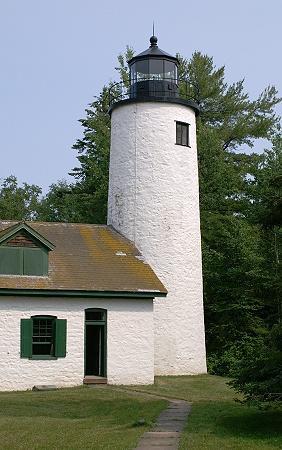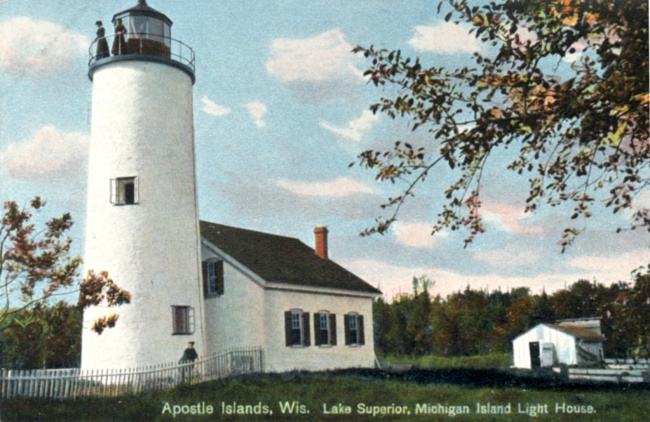
The Michigan Island Mystery
Was the first lighthouse in the Apostle Islands
built on "the wrong island?"
If so, how did that happen?
Historic documents cast light on a puzzle.
Old Michigan Island Lighthouse, 2006
"Oh, for Pete's sake," I said to myself as I read another phony ghost story about an Apostle Islands lighthouse. Most readers will recognize the ingredients: a keeper who dies tragically, a door that slams on its own, spooky noises ever after. It's nonsense, of course. Such tales are easy to debunk when there are good records and you've hung around that lighthouse yourself. Still, once fakelore gets onto the Internet, it's nearly impossible to kill. What I don't understand is why people insist on making up stories when so many lighthouses have genuine mysteries that are even more intriguing if you take the time to dig into them.
Take Michigan Island, for example. If any light station in the Apostles should be haunted, it's this one: the oldest and most historic of the six. The tower's walls hold many mysteries that have puzzled us over the years. Was the lighthouse really placed on the "wrong" island? Who was the first keeper? Is it true that one keeper left the lighthouse for prison? And what of the tale of a lightkeeper's child buried nearby?Historical detective work has brought answers to most of Michigan Island's puzzles, but some still await solution.
The most famous mystery about the whitewashed stone tower is what it's doing on Michigan Island at all. That's definitely not where it was supposed to be.
What happened?
The earliest discussions of a site for the beacon are found in the records of the U.S. Lighthouse Board. In 1852, the Board made plans for several new lighthouses in the country along the wild "northwest lakes." For once, it seemed, the agency was showing foresight. The locks at Sault Ste. Marie would not open Lake Superior to large vessels for another three years. Much of the surrounding territory was still Indian land; it was not until 1854 that the Treaty of LaPointe removed the Ojibwe to reservations and opened the floodgates to white settlement.
It's tempting to guess that the Board's prescience came thanks to the recent departure of Steven Pleasanton, the Treasury's stingy "Fifth Auditor" who did so much to hold back the American lighthouse system while he was in charge, but there is no documentation to confirm or refute that.

Postcard view, c 1910-1920
Among the proposed lights was a marker for the harbor at LaPointe, on Madeline Island. Even in decline, the old fur trade post remained a key spot on Lake Superior. The first thought was to put a tower near the village itself, but after looking over charts, Capt. Lorenzo Sitgreaves, Lighthouse Superintendent in charge, apparently discerned that a light there would be no help to vessels approaching from the open lake.
Instead, a second plan spotted the lighthouse for better visibility, on a nearby strip of sand known variously as Long Island or "Chequamegon Point." That was not the end of uncertainty; Lake Superior was far away and the available information was incomplete. Lighthouse planners had to dig up a map and guess:
"Chagwamegon Point" is not designated by name on the official plat of survey. On the map of the U. States by J. Calvin Smith, published by Sherman & Smith, City of New York, 1851, that point is designated by name, as the extremity of a head land on the main land which would seem to correspond with the Northern extremity of what is called "Long Island" in the public survey.
In July 1854, the plans were set and the contracts were let. Sitgreaves dispatched a representative with a clear mandate:
Mr. Abraham Smolk… is authorized to point out the sites of the Light-Houses, and superintend their construction.
In midsummer 1856, a year behind schedule, Smolk accompanied a crew from the construction firm of Sweet, Ransom, and Shinn to the Apostle Islands, and the yarn grows tangled from here. In October, the workmen left behind a lighthouse not on Long Island, but Michigan Island seventeen miles away.
Why?
Continue to Part Two
|